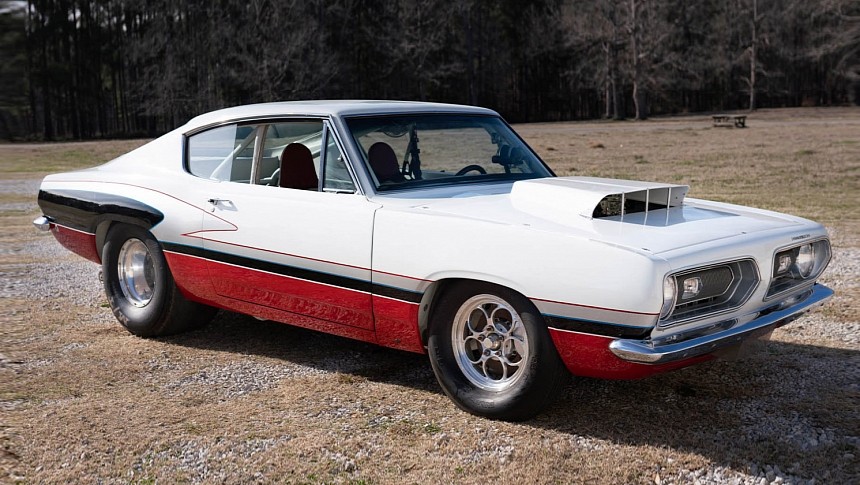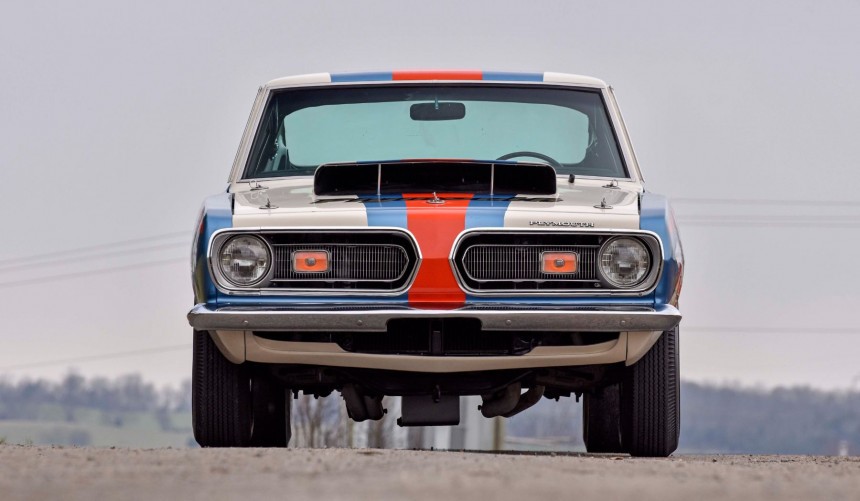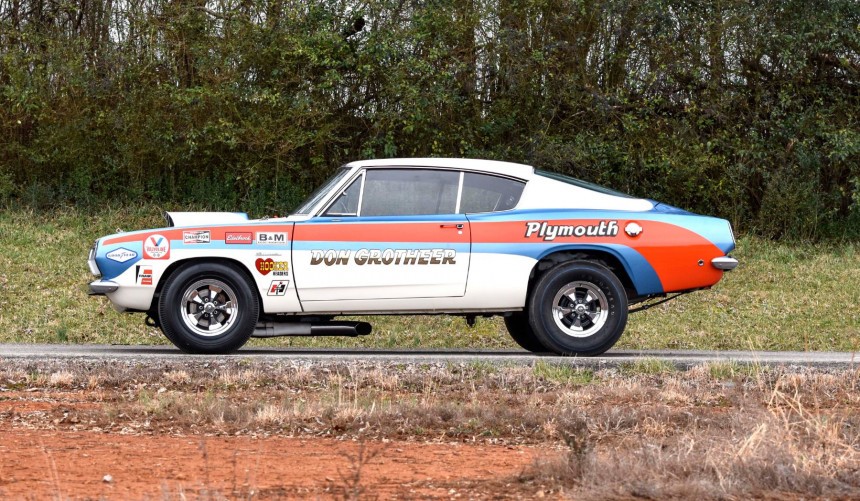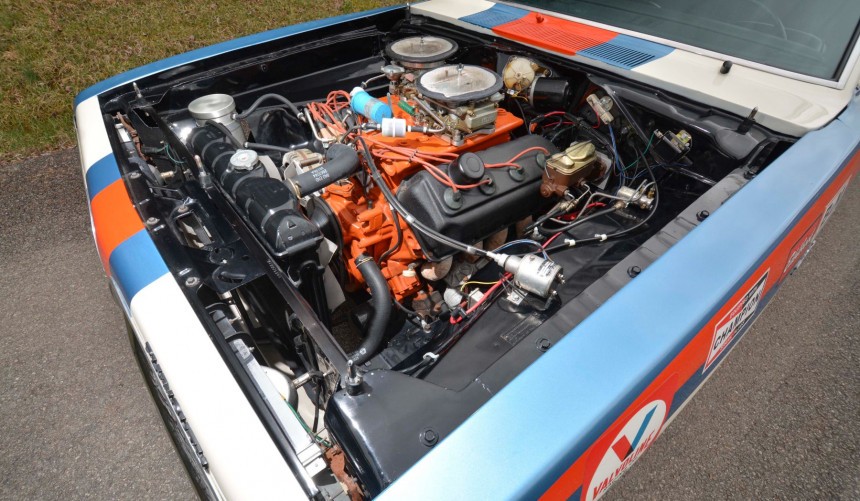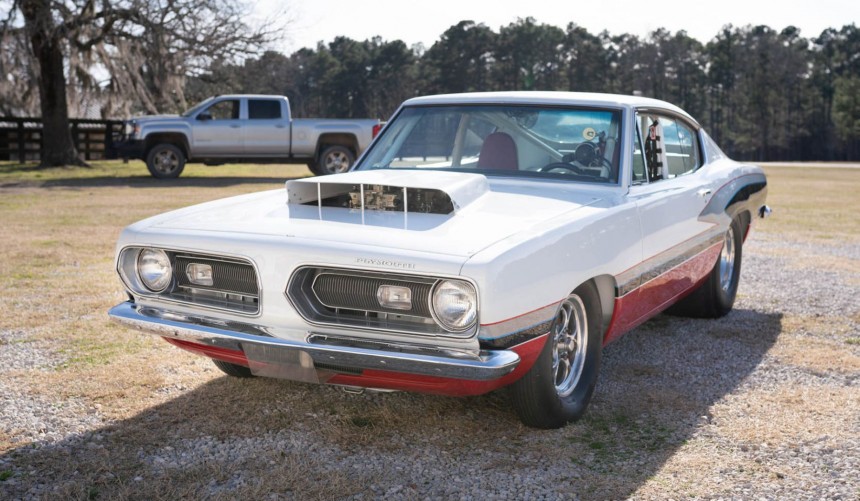Sold in select Plymouth dealerships throughout the 1968 model year and produced in limited numbers, the Barracuda B029 Super Stock is comparable in terms of audacity to today's Challenger SRT Demon 170.
Ford's legendary Mustang is credited for kickstarting the pony car craze, but since its development was the worst-kept secret of the American automotive industry during the early 1960s, rival carmakers were quick to answer.
The quickest was Chrysler's Plymouth division, which introduced the Valiant-based Barracuda about two weeks before the Mustang debuted.
While it became America's first pony car, the first-generation 'Cuda was only available as a fastback coupe and received the same modest engine lineup as the Valiant, which had a massive impact on sales. When the 1964 model year was over, Plymouth's pony car sales totaled 23,443 units, about 103,000 less than Ford's.
The model was continually improved for the next two years, but that did little to improve sales. Consequently, Plymouth decided to drop the Valiant-based design and conceive a brand-new, bespoke Barracuda for 1967.
Not only was the second-generation better-looking, but it was available in three different body styles, and buyers were given a wider range of powerful V8s to choose from.
Nevertheless, the new 'Cuda couldn't get close to the Mustang in terms of sales in 1967, and to make matters worse, Chevy's new Camaro joined the pony car war that year.
In an effort to boost the popularity of the Plymouth Baracuda and Dodge Dart, Chrysler management approved a plan to create two HEMI-powered special editions destined for Super Stock racing.
Therefore, in February 1968, a document detailing the plan was sent to dealers nationwide to gauge public interest. The response was overwhelmingly positive, so both brands went ahead with production.
Codenamed B029, the Super Stock Barracuda was put together with help from Hurst Performance, and apart from the insanely-powerful engine, it received a host of performance upgrades.
Based on the street-legal Barracuda, the dragstrip-only Super Stock was equipped with a heavy-duty rear suspension, and its stock front drum brakes were replaced with a set of discs hugged by four-piston calipers.
To shed weight, the car received fiberglass front fenders and a scooped hood held in place by five metallic hold-downs. Furthermore, the doors were made from thinner, acid-etched steel, and their stock windows were swapped with thinner variants.
The weight-shedding treatment continued inside, where anything deemed unnecessary, like air conditioning, radio, sound deadening, or the back seat, was gutted out. Even the stock carpeting was replaced with a thinner alternative, while the adjustable front seats were replaced by fixed buckets mounted on aluminum frames.
Although it came with a heavier powertrain, the Super Stock - which was delivered to customers without a paint job - only weighed around 3,100 pounds (1,406 kg) thanks to these modifications.
In 1964, Chrysler revived the HEMI engine and took NASCAR by storm. Stuffed inside a Plymouth Belvedere, it was so dominant that the competition's governing body outlawed it for the 1965 season.
A year later, the street version of the gargantuan 426-ci (7.0-liter) Elephant engine was made available to the general public in Chrysler's intermediate and full-size models. Conservatively rated at 425 hp but capable of much more, it quickly became highly sought-after by the drag racing crowd.
However, when Plymouth decided to fit it under the hood of the smaller pony car, they soon discovered that its engine bay was too small. Fortunately, Hurst engineers solved the problem by modifying the shock towers.
After squeezing in the massive powerplant, the engineering team added some performance-enhancing hardware. These included a high-lift cam, two 735-cfm, four-barrel Holley carbs, an aluminum cross-ram intake, Hooker exhaust headers, side-exiting, glass pack mufflers, a high-capacity oil pump, or a heavy-duty radiator with a viscous-driven aluminum fan.
Though it was rated at 425 hp like any other stock HEMI 426, this version's actual output stood closer to 600 hp. Depending on the customer's choice, it could be had with either a synchronizer-less, performance clutch-equipped A833 four-speed or a heavily-modified A727 TorqueFlite three-speed automatic. As expected, both came with Hurst shifters and were linked to a heavy-duty Dana rear end.
Without any other modifications, a Barracuda B029 Super Stock could run the quarter-mile in the low 10s, reaching around 130 mph (209 kph). Few similarly-sized cars could keep up with it back then, but none could do it in factory-spec.
The B029 was also very rare, though the exact number of units produced in 1968 is the subject of debate. Some sources state that 50 were sent to Hurst for the Super Stock conversion, while others argue that the actual number stands around 70. Nevertheless, we do know for sure that fewer Barracudas than Darts were given the HEMI treatment.
Regardless of the actual production figure, it's safe to say that few of them have survived since virtually all were heavily involved in drag racing competitions.
The current value for one of these surviving B029s stands between $100,000 and $400,000, depending on state and racing background. That's surprisingly low for such a rare and iconic muscle car, but it's understandable, considering that finding an unmodified one that retained all of its original components is highly improbable.
If you want to see one of these beasts blasting down the strip, I recommend watching the following video posted on YouTube by Driver Interviews with Bobby Fazio.
The quickest was Chrysler's Plymouth division, which introduced the Valiant-based Barracuda about two weeks before the Mustang debuted.
While it became America's first pony car, the first-generation 'Cuda was only available as a fastback coupe and received the same modest engine lineup as the Valiant, which had a massive impact on sales. When the 1964 model year was over, Plymouth's pony car sales totaled 23,443 units, about 103,000 less than Ford's.
The model was continually improved for the next two years, but that did little to improve sales. Consequently, Plymouth decided to drop the Valiant-based design and conceive a brand-new, bespoke Barracuda for 1967.
Not only was the second-generation better-looking, but it was available in three different body styles, and buyers were given a wider range of powerful V8s to choose from.
Nevertheless, the new 'Cuda couldn't get close to the Mustang in terms of sales in 1967, and to make matters worse, Chevy's new Camaro joined the pony car war that year.
Attempting to win the war on the dragstrip
Therefore, in February 1968, a document detailing the plan was sent to dealers nationwide to gauge public interest. The response was overwhelmingly positive, so both brands went ahead with production.
Codenamed B029, the Super Stock Barracuda was put together with help from Hurst Performance, and apart from the insanely-powerful engine, it received a host of performance upgrades.
An improved chassis combined with a lighter body
To shed weight, the car received fiberglass front fenders and a scooped hood held in place by five metallic hold-downs. Furthermore, the doors were made from thinner, acid-etched steel, and their stock windows were swapped with thinner variants.
The weight-shedding treatment continued inside, where anything deemed unnecessary, like air conditioning, radio, sound deadening, or the back seat, was gutted out. Even the stock carpeting was replaced with a thinner alternative, while the adjustable front seats were replaced by fixed buckets mounted on aluminum frames.
Although it came with a heavier powertrain, the Super Stock - which was delivered to customers without a paint job - only weighed around 3,100 pounds (1,406 kg) thanks to these modifications.
The first Mopar pony with an Elephant heart
A year later, the street version of the gargantuan 426-ci (7.0-liter) Elephant engine was made available to the general public in Chrysler's intermediate and full-size models. Conservatively rated at 425 hp but capable of much more, it quickly became highly sought-after by the drag racing crowd.
However, when Plymouth decided to fit it under the hood of the smaller pony car, they soon discovered that its engine bay was too small. Fortunately, Hurst engineers solved the problem by modifying the shock towers.
After squeezing in the massive powerplant, the engineering team added some performance-enhancing hardware. These included a high-lift cam, two 735-cfm, four-barrel Holley carbs, an aluminum cross-ram intake, Hooker exhaust headers, side-exiting, glass pack mufflers, a high-capacity oil pump, or a heavy-duty radiator with a viscous-driven aluminum fan.
Though it was rated at 425 hp like any other stock HEMI 426, this version's actual output stood closer to 600 hp. Depending on the customer's choice, it could be had with either a synchronizer-less, performance clutch-equipped A833 four-speed or a heavily-modified A727 TorqueFlite three-speed automatic. As expected, both came with Hurst shifters and were linked to a heavy-duty Dana rear end.
Incredibly fast and very rare
The B029 was also very rare, though the exact number of units produced in 1968 is the subject of debate. Some sources state that 50 were sent to Hurst for the Super Stock conversion, while others argue that the actual number stands around 70. Nevertheless, we do know for sure that fewer Barracudas than Darts were given the HEMI treatment.
Regardless of the actual production figure, it's safe to say that few of them have survived since virtually all were heavily involved in drag racing competitions.
The current value for one of these surviving B029s stands between $100,000 and $400,000, depending on state and racing background. That's surprisingly low for such a rare and iconic muscle car, but it's understandable, considering that finding an unmodified one that retained all of its original components is highly improbable.
If you want to see one of these beasts blasting down the strip, I recommend watching the following video posted on YouTube by Driver Interviews with Bobby Fazio.
